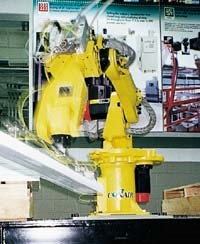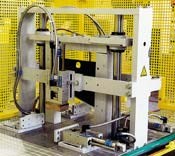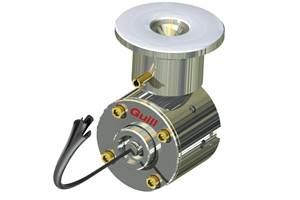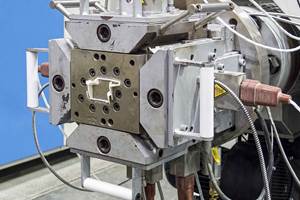How to Get 50% Higher Output Of Large PVC Profiles
With the right combination of die and cooling technologies, there’s no reason why extruders of large, complex PVC profiles cannot get up to 50% faster throughput than they are now used to.
With the right combination of die and cooling technologies, there’s no reason why extruders of large, complex PVC profiles cannot get up to 50% faster throughput than they are now used to. A capacity crowd of more than 50 processors saw that proposition demonstrated in late April at a technology open house at the Conair Technical Center in Pittsburgh. They witnessed extrusion of rigid PVC fence rail at 22-24 ft/min, as compared with normal rates of 14-16 ft/min. The coextruded profile measured 1.5 x 5.5 in. and had two center legs that divided it into three hollow box sections. Nominal wall thickness was 0.100 in. Throughput rate was in the range of 1300 lb/hr. This performance was achieved using an actual customer die and a combination of the latest downstream technologies from Conair and other companies, including an improved water-mist spray tank, cryogenic cooling, and a robot stacker. Conair also announced new agreements to market blenders and cutoffs from two European firms.
Pushing the limit
The demonstration line used two twin-screw extruders from ExtrusionTek Milacron, Batavia, Ohio. The vinyl substrate was processed by an Atlas 114 parallel twin-screw capable of 1000-1500 lb/hr of profiles. The 114-mm, 26:1 machine is the second-largest in the Atlas line, which includes a 135-mm model and will be supplemented with a 172-mm version later this year. Capstock was coextruded by a Pinnacle E55 conical unit with a 55-mm discharge diam. It puts out 400-600 lb/hr.
The main extruder was fed by a Graviblend Plus continuous gravimetric blender from Colortronic GmbH of Germany (represented here by Colortronic, Inc., Runnemede, N.J.). Under a new marketing agreement, Conair will offer Colortronic gravimetric blenders for powder feeding, complementing Conair’s AutoWeigh gravimetric blenders for pellets.
The die was built by Kansas American Tooling (KAT), McPherson, Kan. Unlike conventional and less-precise approaches that were originally developed for coextruded pipe but are also frequently used for large profiles, KAT introduces the capstock just 1 in. from the die lips. This is said to allow better dimensional control and to cut usage of capstock material by up to one-third.
Contributing to the high output of the demo line was the internal cooling system used by KAT. The three closed channels inside the fence rail trap hot air, which retards cooling. To combat this, KAT drilled air holes in the mandrels that form the hollow sections of the profile, venting them out through the spider mandrel supports and finally through bolt holes in the die housing. Slight air pressure can be applied to the vents to blow out the hot air.
As noted by one of the processors attending the demonstration, such approaches have been tried before with varying success. The problem is that hot air is blown out of the cut end of the profile, but air flow is choked off while the saw cuts the profile. That can cause a momentary inflation of the profile. In the demonstration at Conair, no mark was left on the profile because of the brief cycle of the Conair traveling saw and the fact that the saw blade had perforations to let air through.
KAT also supplied six 8-in. dry-sleeve calibrators that were situated just downstream of the die. They had vacuum slots at 1-in. intervals and internal water-cooling jackets. The extra-high output of this demonstration line required roughly twice as many calibrating sections as are normally used.
KAT provided 110 templates of low-friction UHMWPE for use in Conair’s High-Intensity Spray Cooling Tank, which was introduced last year at the NPE show. That tank has since been enhanced to include a water and vacuum manifold to accommodate tooling for more complex, multi-hollow profile shapes. KAT president Kenton Gearhart, a 30-year veteran of PVC profile extrusion at CertainTeed and American Maplan, says he has never seen a cooling tank as efficient as this one. Its fine spray mist of water flashes into steam the moment it hits the hot profile. According to Conair downstream product manager Bob Bessemer, this method of cooling is more effective than complete immersion of the profile in a water bath. In a bath, a layer of warm water around the profile retards cooling. It is difficult and costly to disrupt that warm layer with turbulence. Also, air bubbles form on a profile in an immersion tank and can leave pock marks in the surface.
Conair’s spray tank pumps 360 gal/min vs. 100 gal/min for typical cooling tanks, Bessemer says. The 24-ft tank would cost $40,000 to $45,000 as equipped for the open house.
The big chill
Another important contributor to the record-setting output of the Conair demo line was the EC2000 Nitrogen Gas Cooling Tank built by Material Enhancement Inc. (MEI) of Effingham, Ill., and marketed by Conair. It uses liquid nitrogen, which is allowed to expand into a gas before it enters the insulated cooling tank. The nitrogen, initially at –320 F, recirculates along the axis of the tank until a temperature sensor detects warming sufficient to cause some fresh cold nitrogen to be introduced, expelling the warmer gas. High-velocity N2 circulation along the axis of the profile reportedly allows the gas to cool inside projections on the product much better than if the gas were circulated radially around it. The tank has two independent cooling zones. The 8-ft model used costs about $49,000.
Conair says some half-dozen processors are beta-testing the nitrogen cooler. One firm is using three of them in commercial production of PVC foam profiles and would like to buy five more. “It really shines in foam profiles,” says Conair v.p. of extrusion sales Ernie Preiato. “It controls the foam expansion so as to permit good dimensional accuracy.”
Robot lends a hand
Production of large profiles at high throughputs can tie up labor to remove finished product from the line. For that reason, some European processors have adopted robot handling devices and several U.S. firms are considering doing likewise, Preiato says. To demonstrate the idea, Conair placed a small Fanuc M6i jointed-arm robot at the end of the line to pick fence rails off a conveyor using vacuum grippers and then place the profiles in stacks. This model can lift 13 lb and has a 54-in. reach. It costs about $50,000. Conair markets the unit through an agreement with Fanuc Robotics North America, Rochester Hills, Mich.
‘Chipless’ cutting
Although it was not used in the demonstration, a new “chipless” cutoff device was also shown at the open house. It is available from Conair through a new agreement with cpm GmbH of Germany. The ProCut device uses a traveling, heated shear blade. The very thin (0.02-0.047 in.) blade is held in tension, and the profile itself is gripped and stretched slightly by the device as it is cut. The blade descends relatively slowly, propagating a crack through the vinyl ahead of the blade. It reportedly creates no heat, noise, or dust and leaves a smooth, polished-looking edge. Another reported advantage of this device is that it cuts soft beads coextruded with rigid vinyl, instead of tearing them like saws commonly do. Models are available for use at line speeds up to 52 ft/min. ProCut is used with PVC, polyethylene, and other ductile materials—even foams. It is not suitable for brittle plastics.
Related Content
Spiderless Pipe Die Touts Material Savings
Capable of providing a finished extrusion with OD from 2 in.-15 in.
Read More'Hybrid' Die Design Eliminates Weld Lines, Cuts Stagnation
NPE2024: Newest extrusion tool retains benefits of previous design and adds features to boost quality.
Read MoreAuto-Profile System for Blown Film Rotating Dies
NPE2024: New technology can slash gauge variation by 50%.
Read MoreIs Your Die Flow Changing Despite Following All the Correct Formulas?
Maybe the problem is that you're starting up with a dry die. Here are tips to solve this issue.
Read MoreRead Next
Advanced Recycling: Beyond Pyrolysis
Consumer-product brand owners increasingly see advanced chemical recycling as a necessary complement to mechanical recycling if they are to meet ambitious goals for a circular economy in the next decade. Dozens of technology providers are developing new technologies to overcome the limitations of existing pyrolysis methods and to commercialize various alternative approaches to chemical recycling of plastics.
Read MoreHow Polymer Melts in Single-Screw Extruders
Understanding how polymer melts in a single-screw extruder could help you optimize your screw design to eliminate defect-causing solid polymer fragments.
Read More (2).jpg;maxWidth=970;quality=90)









 (2).jpg;maxWidth=300;quality=90)






 (1).jpg;maxWidth=970;quality=90)